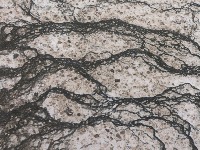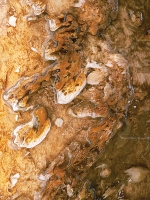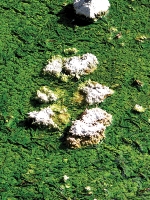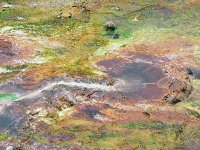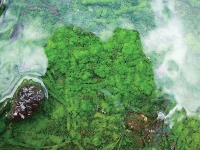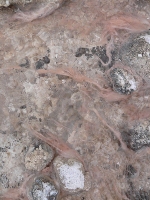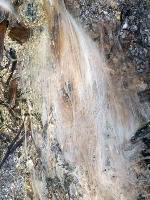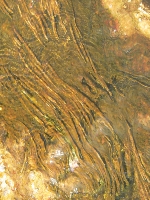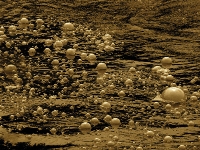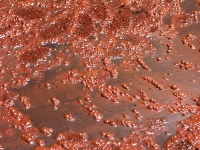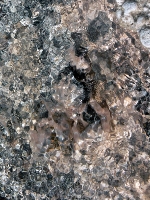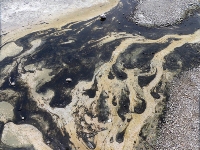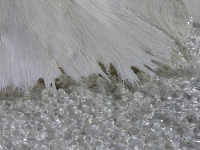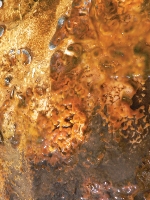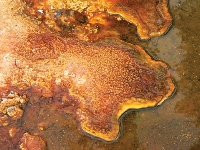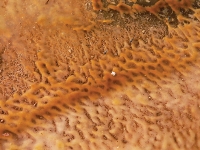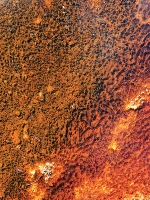Winter 2007, Volume 23.2
Essay & Art

Craig Oberg
Bear, Bison, and Bacteria: The Microbiology of Yellowstone Park
Photos of the Microbiology of Yellowstone
Craig Oberg is Professor of Microbiology at Weber State University where he also serves as department chair. A Hinkley Fellow, recipient of the Seager and the Dixon awards in teaching, and Presidential Distinguished Professor; he is the author of over 90 scientific articles on dairy microbiology and microbial ecology. He also co-edited The Search for Harmony—Essays on Science and Mormonism (with Gene Sessions) and Fishing Untouched Waters (with Dave Scadden). Craig lives in Liberty, Utah, with his artist wife, Lynette.
Over 600,000 years ago, in what is now known as the North American Continent, a mountain range twice the size of the Tetons disappeared in minutes, vaporized to a continent-covering ash cloud. Its scar is now one of the world’s great natural wonders, a paradise teeming with wildlife. Here, in one of our most popular national parks, sometimes called the Serengeti of North America, the continent’s largest predators and their prey play out the cycle of life for all to view. Large, impressive beasts take center stage—the feared and hump-backed grizzly bear, the wolf, and the coyote, regal elk, moose, and herds of shaggy bison. These large beasts and their story dominate the beautiful and rugged landscape. But, here also exists another world, a smaller world—the world of microorganisms. Simultaneously and symbiotically this world lives with its larger siblings. Here this microscopic world reveals itself in a rare beauty matching the grandeur of its magnificent mammalian counterparts. Just as the Park’s stately elk and belligerent bison are beautiful to observe, so are its most diminutive denizens, which provide a kaleidoscope of prismatic pigments radiating from each thermal feature they inhabit.
Now, geysers, hot springs, mud pots, and fumaroles landscape this ancient caldera, remnants of that same cataclysmic volcanic explosion. Most visitors today fail to appreciate that the striking colors, the vivid striations, and even the unique geological structures of Yellowstone’s geysers and thermal pools are the result of microscopic organisms, the really small beasts, as they go about their business. Earth’s most amazing life-forms inhabit and build Yellowstone’s landscape and thermal features. By the billions they fill every conceivable, and even inconceivable, ecological niche.
In the thermal features of Yellowstone National Park visitors can witness a magnificent visual display of microorganisms, and even smell and taste the metabolic efforts of these remarkable creatures. Visitors gaze at the incredible colors in the thermal pools, marveling at the beautiful "mineral deposits," little realizing these colors are really mats of living organisms—biofilms, communes made up of billions of microorganisms spread across the landscape like a showy quilt of color and texture—adapted to the harshest environments life can withstand. Minute creatures comfortably thrive under conditions that would boil an egg or even dissolve a wayward bison. Extremophilic microorganisms not only grow in such extreme environments (hence their name), they require it. Extremophiles are not normal organisms barely surviving abnormally severe conditions, but organisms that can only thrive in harsh habitats, obligated to spend their existence in severe settings or perish. Their molecular adaptations demand these draconian conditions. Extremophiles would be just as uncomfortable in our world as we would be in theirs.
Just as rapid national park status provided a refuge for dwindling populations of wildlife, it also prevented exploitation of geothermal resources, preserving a microscopic world originating in the primordial past. Prevention of thermal commercialization in Yellowstone Park now allows several million people each year to experience intimate contact with the vestiges of early Earth along with its most primitive life-forms, living fossils suspended in superheated water. Thermal features in Yellowstone exhibit amazing geological diversity on their own, from neutral chloride environments in the Upper and Lower Geyser Basins to the huge calcium carbonate mounds of Mammoth Hot Springs to the battery-acid silica mud of Norris Geyser Basin and the Mud Volcanoes. Different mineral strata in the underlying rock are a major reason for the wide diversity of these unique features. The pH (a measure of acidity or alkalinity) ranges from 1 to 10 on a scale of 0 to 14 with many features also containing inordinately high concentrations of metals such as mercury and aluminum. Ten thousand thermal entities lie within the Park’s borders comprising 80 percent of the world’s geysers and 60 percent of the Earth’s known thermal features, each feature unique and full of microbial activity.
If Yellowstone National Park is North America’s Serengeti, it is also its microscope, allowing us to peer directly into the microbial world to view its most beautiful and bizarre organisms. Touring Yellowstone’s thermal-feature areas reveals an incredibly diverse microbial world with its beauty prominently visible even to the casual observer.
Norris Geyser Basin
Situated on the Park’s west side, midway between Madison Junction and Mammoth Hot Springs, lies Norris Geyser Basin, named for an early Park superintendent. Norris Geyser Basin is the hottest, most dynamic thermal area in the Park, located at the junction of intersecting faults and nearest to the subterranean magma bubble. It is also one of the most acidic with the boiling water in its thermal features 10,000 times more acidic than your pH-balanced shampoo. Interpretive rangers assigned to Norris Basin report their shoes dissolving away during the summer tourist season, the result of treading around in this battery-acid environment. Norris is also one of the most active with changing thermal activity resulting in some areas being periodically closed to public access. Acid-dissolved subterranean rock strata in the area necessitate extra care, hence carefully placed paths and boardwalks span Norris’s harsh habitats.
High acidity and boiling temperatures preclude some types of microorganisms from inhabiting the moonscape of Norris Geyser basin. Cyanobacteria, photosynthetic multi-pigmented bacteria, which supply much of the color at Mammoth Hot Springs and in the Firehole River Geyser Basin, prefer a neutral pH just like the majority of plants and animals. These microbes act as a natural litmus test for Yellowstone’s fervid waters. Most of the colors in Norris are therefore due to dissolved minerals (silica turns the acid water a beautiful blue) or to several acid-loving algae. Hence, Norris Geyser Basin is a bit drab, lacking the colorful microbial mats abundant in the thermal features around Old Faithful. However this does not mean the geyser basin is devoid of life—indeed, just the opposite is true. Samples delicately fished out from inside geysers and fumaroles with modified golf ball retrievers show they are full of microorganisms specially adapted to this incredibly harsh environment.
Geyser runoff channels are biological thermometers, full of organisms replicating right up to the very limit of their temperature tolerance. Algae, comprised of eukaryotic cells (more complex in structure and larger in size than the simplistic prokaryotic cells), cannot perform photosynthesis above 55oC. Therefore, one need only to look for the long streamers of Cyanidium to know where the water has cooled to that temperature as it starts the long journey to the sea. Algae are categorized based on the complement of light-gathering pigments they contain. This taxonomy can be a bit deceiving since the two predominant algae in the Norris runoff channels are not what they seem. Cyandium is a "red algae" that appears green and Zygogonium is a "green algae" that appears red or, at least, purple. This certainly suggests that taxonomists have a ways to go before we all buy into their descriptive classification of life.
Farther up the road towards Mammoth Hot Springs an even stranger microbial phenomenon exists along the shores of Nymph Lake, a small body of water that the vibrantly green and acidic Nymph Creek feeds. In 1973, scientists found Dactylaria, a pathogenic turkey fungus, growing along its warm shore in microbial mats with Cyanidium caldarium, the "green algae," and Bacillus coagulans, a spore-forming bacteria touted in the past as the spore-forming lactobacillus used in probiotic mixtures to improve human digestion. Dactylaria secretes a distinctive reddish-purple pigment, and purplish patches dot the mud flats of Nymph Lake. This fowl fungus has been isolated from other Yellowstone acidic thermal features being particularly prevalent in turbulence-generated foam. It is therefore no wonder wild turkeys do not wander Yellowstone Park.
Strolling up Nymph Creek is a bit like following Dorothy’s yellow brick road, except this one is paved in a bonny bright green. In the shade of lodgepole pines, the acidic thermic water flows over a mat of Cyanidium caldarium enjoying its perpetual hot tub life. In the shade, the algae express more light-gathering green pigment that makes the creek seem to fluoresce. Feeding the creek are numerous near-boiling hot spring tributaries. As the water rapidly cools to only scalding temperature, outlet channels fill with waving filaments, Hydrogenobaculum, undulating underwater like delicate sulfur-coated angel hair. This microorganism is an autotrophic aerobe that oxidizes hydrogen and elemental sulfur, inhabiting water between 70 and 75oC. This is still pretty hot, inasmuch as your average water heater is usually set at 45oC. Its closest relative is Aquiflex (the deepest and oldest branch on the bacterial tree) making these graceful filaments quite ancient.
Mammoth Hot Springs
In the northwest corner, Yellowstone Park Headquarters is nestled next to a huge thermal feature, a mountain built from regurgitated limestone. Originally called White Mountain Hot Spring, and providing the backdrop for the U. S. Army’s original Fort Yellowstone, this thermal feature earns its name. Five hundred gallons of water per minute flow up through Mammoth Hot Springs via more than 50 thermal springs. The heated water probably originates in the Norris Basin but cools somewhat on its 20-mile subterranean journey. The bubbling in the Mammoth thermal springs is due to carbon dioxide gas coming out of solution, just like the foam on a freshly opened soda bottle. Two tons of dissolved limestone rises to the surface from subterranean sediments and is deposited as travertine at the rate of a foot a year. Near the center of each hot spring, macroscopic, white streamers radiate out in the super-heated water. When the water reaches the surface and the carbon dioxide bubbles off, dissolved calcium carbonate comes out of solution and deposits on the first thing it touches, usually hyperthermophilic microorganisms, including Thermothrix thiopara. A chemosynthetic sulfur autotroph that oxidizes sulfur, this rather finicky organism lives at the sulfide-oxygen interface consuming sulfur and avoiding oxygen. On the reducing side of the oxygen interface, Thermothrix forms its characteristic white streamers, but on the oxidizing side, filaments fragment into single cells, a process that suggests how this organism can inoculate the new thermal springs constantly appearing in the Mammoth formation. Coated with calcium carbonate, the scientific name for limestone, fossilization freezes each strand, building Mammoth Hot Springs one encrusted bacterial filament at a time. Calothrix species, associated with cyanobacteria and diatoms, also play a role in the formation of hot spring terraces and cones, including the signature terraces at Mammoth Hot Springs. Their filaments grow in tufts or clumps of accumulating travertine and play a role in rock deposition for these thermal features. The beauty of the microscopic world manifests itself as jewel-coated necklaces adorning each thermal spring.
Aside from determining just how related humans are to chimps, no pursuit in biology seems more compelling than determining if we are alone in the galaxy, or if, perhaps, our nearest neighbor planets also contain life. This question has led planetary scientists to investigate Mammoth Hot Springs to study its fossilized microbial filaments. It is still rather difficult, at the moment essentially impossible, to get a sample from Mars or one of Jupiter’s moons to spread on a Petri plate, but the vestigial evidence of microbial activity might be right before our satellite-transported telescopic eyes.
Biological terra-forming is what draws NASA scientists to Mammoth Hot Springs to examine a geological wonder featuring rock-coated extremophiles. The role of microbes in a thermal feature’s fabrication on Earth suggests that extraterrestrial features on neighboring planets and moons may have been formed in a similar manner. Associating a geological feature with evidence of life in a photograph is certainly easier than ferrying a sample for analysis back to Earth from a distant orb. A study of Angel Terrace revealed the travertine (calcium carbonate) was 80 meters thick, deposited over more than 8,000 years at the rate of 5 millimeters a day, or about a meter a year. No wonder Mammoth Hot Springs looks a little different from year to year. Another reason for its continual alterations is that solidifying calcium carbonate readily plugs up the hot water vents, shifting the water’s course to force new springs to sprout up, a real challenge for maintenance workers building boardwalks.
As the water cools below 55oC, bacterial photosynthesis can take place to create a kaleidoscope of color on the travertine terraces. A cyanobacteria common at Mammoth Hot Springs is Phormidium laminosum, filamentous, its membrane folds containing a wide range of additional pigments besides chlorophyll. In full sun it appears orange, in partial sunlight blue green, and in shaded areas red. This sun-induced gradient of color is readily visible on Orange Mound, a prominent feature on the Upper Mammoth Terrace Drive. One study revealed 657 individual species of microorganisms inhabiting Mammoth’s colorful terraces, providing a reason for its radiant colors, liquid rainbows cascading from pool to pool. In addition, the high elevation and lack of shade for many of the thermal springs increases ultraviolet exposure so these microorganisms produce more pigments for protection. These bacterial sunscreen carotenoids come in all colors, red to yellow to blue, protecting the cell’s sensitive macromolecules from UV-induced damage. Mosty, of course, all of this activity results in a striking beauty.
Lower Geyser Basin
Between Lower Geyser Basin and Midway Geyser Basin is Firehole Lake Drive, home to the Great Fountain Geyser, 150 feet in diameter. Near the Great Fountain Geyser parking lot is the unmarked trailhead for White Creek, and 300 yards up that trail percolates Octopus Spring, one of the most studied thermal features in the park. Named because its runoff channels fan out like an octopus’s arms, it has been the focus of research aimed at unraveling the intricacies of the thick microbial biofilms surrounding its boiling, sinter-shelved pool.
Biology laboratories often portray microorganisms as an accumulation of single cells suspended in an environment with no rhyme or reason to their unicell anonymity. Only when these solitary cells are inoculated on a favorable media, an agar-filled Petri dish perhaps, do they manifest their collective nature as a visible colony. In reality, most microorganisms in nature, if left undisturbed, cling together to form biofilms (the most well known being dental plaque). Under the microscope these complex communities resemble big city high-rises, a conglomeration of minute organisms dependent on each other for providing a nurturing and protective environment. Collectively they concentrate nutrients, resist environmental hazards, and recruit others to their cellular commune. The bane of medical implants and food processing equipment, organisms in these microbial biofilms communicate by chemical signaling, alerting each other to collectively express particular metabolic traits.
Inch-thick biofilms, containing a multiplicity of microorganisms, congeal in the outlet channels of many thermal features, especially the neutral chloride hot springs along the Firehole River. At the bottom of Terrace Spring, just north of Madison Junction, spreads a thick biofilm punctuated with the hoofprints of bison that warmed there during the winter. These biofilms also color the calcium carbonate cascades of Mammoth Hot Springs with the hues of a Crayola box (the really big one with all the crayons that have weird names). The stuff that holds these microbial mats together is the same type of compound that gives yogurt and mayonnaise its texture—sugars in a chain secreted to bind oneself to its neighbors, mucilaginous microbial bonding. Some organisms can move through the mat as conditions dictate, particularly intense sunlight, but most are content in their narrow protective niche. Mats change color with the seasons, a sun-induced kaleidoscope, as a visit to these mats in winter will attest.
All the geyser basins between Madison Junction, the confluence of the Gibbon and Firehole Rivers, and Old Faithful are comprised of neutral chloride thermal features, plenty hot but with a pH near 7, neither too acidic nor too basic, just right. A cross section of the mat surrounding Octopus Spring reveals a microbial lasagna layered with red and green bands of photosynthetic bacteria. The upper one-millimeter, the photic zone, is primarily Synechococcus lividus, a thermophilic unicellular cyanobacteria requiring plenty of oxygen. Synechococcus utilizes a light-dependent gliding motion, rotating to optimize light exposure, an unusual feature for cyanobacteria. Electron microscopy reveals that the sausage-shaped cells assume an upright position at high noon, but remain randomly oriented the rest of the day, single-celled sunflowers tracking the solar power source during its zenith. The middle and lower mat sections contain Chloroflexus aurantiacus, a gliding, filamentous, photosynthetic, phototrophic, thermophilic bacteria, living either aerobically or anaerobically with the light-harvesting chlorosomes of green sulfur bacteria and the facultative metabolism of purple nonsulfur bacteria. Is there anything the filamentous factotum Chloroflexus cannot do? Not only does this organism form resplendent microbial mats with its associates, it also performs metabolic magic which, though perhaps not visually enthralling, is certainly beautiful to a microbiologist.
Biofilms grow only on the top layer, the photosynthetic layer, and a close examination of the biofilm’s surface at Octopus Spring reveals a microscopic forest, miniature metabolizing stromatites suggesting this mat as an analog of Precambrian mats that covered the Earth long before dinosaurs consumed its photosynthetic progeny, vascular plants. One study found at least 16 different organisms in the biofilm, 11 being photosynthetic cyanobacteria that contain a wide variety of pigments, expressed as light intensity dictates. The biofilm’s beauty changes with the season, a chromatic calendar created by microbial impressionist painters. Artists often portray early Earth as a drab and dreary setting, but these thermophilic biofilms suggest it could have been quite the prismatic place as microbial life developed. The myriad of bacterial pigments found in both aerobic and anaerobic microorganisms may be vestiges of a primordial world bathed in powerful ultraviolet radiation as the oxygen atmosphere slowly developed due to the waste products of microbial metabolism. Mat color and intensity change with the Earth’s rotation; summer requires microorganisms to cover up with red and orange pigments that protect them from the sun’s invisible (DNA-destroying) radiation. Each cell produces SPF-shielding pigments to shade its metabolic membranes. Reduced winter light brings out the chlorophyll, revealing the green pigments masked by their summer sunscreen.
Octopus Spring’s runoff channel also contains the unique Thermocrinis ruber, originally described by microbiologists in their reports only as the "pink filaments." These cotton candy streamers only inhabit that portion of the outlet channel between 84 and 88oC, making it the rarest of Park creatures. More than 30 years ago, these visible microorganisms helped start microbiologist Thomas Brock on his hyperthermophilic quest. Although it is filamentous while clinging to this climate-controlled sanctuary, when propagated in the laboratory only single cells (with monopolar polytrichous flagella for motility and forming reddish-brown colonies) result. Exhibiting this dimorphic schizophrenic appearance suggests that domesticating microorganisms on Petri plates during environmental sampling may not reveal their true natural state. Perhaps its filamentous form is an adaptation to keep it in its thermophilic asylum. Laboratory studies noted a generation time of only 70 minutes, very rapid reproduction by any standard, even a bacteria’s. Thermocrinis ruber is very happy indeed in its square-meter world, a peaceful refuge in a hostile universe.
Mushroom Pool
Thomas Brock, in the mid 1960s, picked a thermal feature just around the corner from Octopus Spring to change the biological view of the world or, at least, the limits of biological life. By simply placing a glass microscope slide in the outlet channel of a rather modest thermal feature, he set off a great race to find the absolute limit of life. Prior to his startling discovery, most biologists felt that life could not exist much above 55oC, the limit for eukaryotic (plant) photosynthesis. While that is still the limit for plants and animals (everything eukaryotic), it is not even close to what scientists have discovered since that thermophilic epiphany. The thermometer for viability has risen ever since, from simmering to boiling (100oC or 212oF at sea level) and beyond. Due to its altitude, thus reduced atmospheric pressure, the boiling point in Yellowstone is only 92.5oC, still too hot for most organisms to abide. Scientists now know of microorganisms that can survive autoclaving for a brief period. (An autoclave is a sterilizer like the pressure cooker used to can tomatoes in the home, anathema to microbes since these devices are what microbiologists use to sterilize everything, creating the aseptic environment necessary for their profession.) Fortunately, these particular hyperthermophiles are few and far between, confined to places humans seldom tread.
If boiling water quickly coagulates egg protein and melts butter, how do microorganisms comprised of these same compounds, protein and lipid (the scientific name for fat), not do the same? Fortunately for us, most microorganisms succumb to high temperatures, thus making pasteurization and commercial dishwashers effective antimicrobial agents. Since hyperthermophilic microorganisms are made up of essentially the same biological molecules as dogs and daffodils, what allows them to flourish in environments so detrimental to the rest of Earth’s inhabitants? The answer turns out to be a combination of lots of little molecular changes, the culmination of which allows life in the extremes. Several amino acid substitutions in the sequence of a protein allow it to remain functional under scalding conditions. A few more ionic bonds and becoming a little more hydrophobic are all it takes to transform a normal protein into a thermophilic one. Heat-loving microorganisms also synthesize chaperone proteins, molecular vise grips that bind to enzymes, forcing them to maintain metabolic functionality at high temperatures.
Cell membranes are made up of lipids, a fatty acid bilayer sprinkled with transport proteins providing adjustable permeability, thus allowing nutrients in and waste products out at the cell’s discretion. Hyperthermophiles use fatty acids rich in saturated fats, bad for a person’s heart but great for avoiding a meltdown at high temperatures. Hyperthermophilic organisms replace their membrane’s fatty acids with dibiphytanyl tetraether lipids, fusing the bilayer into a monolayer that results in membranes that will not melt under boiling conditions. A common laboratory procedure to denature DNA, the cell’s molecular blueprint, is to heat it up to cause strand separation. Temperatures in Yellowstone’s thermal features would work just fine on most microbes’ DNA, but hyperthermophiles contain an unique enzyme, reverse DNA gyrase. This enzyme places positive supercoils in DNA instead of the negative supercoils found in most microorganisms; backwards folding significantly increases the resistance of DNA to heat-induced denaturation. Other microorganisms secrete a unique compound into their cytoplasm, anti-antifreeze, helping macromolecules maintain their shape. A whole lot of little changes allow life at high temperatures. Is there a limit to all this? Of course there is; we just have not found it. Beauty is only skin deep, but among Yellowstone’s microorganisms adaptive beauty penetrates all the way through the cell, resulting in remarkable survival.
Aside from being the discovery site for extreme thermophiles, Mushroom Pool, or at least an inhabitant, became famous a second time. An enzyme isolated from one of its inhabitants, Thermus aquaticus, revolutionized modern biology, doing for genomics what the printing press did for books. Prospectors in search of the mineral mother lode crisscrossed the West for a hundred years seeking their fortune. Today, speculative prospecting continues in the thermal features of Yellowstone as the quest continues for unique enzymes, microbial protein catalysts that can mediate industrially important chemical reactions under extreme conditions.
Geological survey characterization of Yellowstone’s thermal features reveals the broadest range of extreme living conditions accessible anywhere. Combinations of torrid temperatures, high acidity, and toxic metals, with several thermal features containing mercury levels poisonous to most life, haunt its infernal reaches. Astonishingly, in each of these habitats microorganisms flourish, selected over eons to metabolize, degrade, and synthesize compounds under such unbelievably harsh constraints. It is merely a matter of matching the industrial conditions for a chemical reaction with the appropriate thermal feature.
Bioprospecting, the search for commercially applicable microorganisms and their attendant enzymes, occurs worldwide, and it ardently proceeds in Yellowstone’s hot pots, geysers and fumaroles. Test tubes and sample flasks now replace high-powered rifles; the extended arms of modified golf ball retrievers reach into thermal features to probe a bizarre microbial world, searching for metabolic miracles. Microbial enzymes, super-efficient catalysts, can be used to synthesize products or degrade toxic wastes to harmless residues. Enzymes extracted from microbes are used to make high fructose corn syrup, debitter orange juice, clot milk, and treat stroke victims. Until recently their only drawback was the narrow range of conditions in which they were functional. Thomas Brock changed all this.
The most famous microbial product ever fished out of a Yellowstone thermal feature is Taq polymerase, the enzyme catalyst for the polymerase chain reaction (PCR), often called the most important scientific technology in the past 100 years. PCR, developed in 1983 by Nobel laureate Kary Mullis, is a test tube method to amplify a single DNA sequence into millions of exact copies. Now Taq polymerase is the basis for a multimillion-dollar industry that has revolutionized all of biology from forensic analysis to cancer research. PCR is even the basis for taking molecular snapshots of the microorganisms present in thermal features, including all the ones that cannot currently be propagated in the laboratory. Most discoveries from bioprospecting today are proprietary with the patenting of a microorganism and its components done quietly and behind the scenes, giving a company exclusive claim to its metabolic functions. It does seem a bit obscene for a relatively recent lifeform like humans to lay claim to owning a lifeform that has been on the planet for more than a billion years. But Archaea and bacteria have seen trilobites and triceratops, stegosaurus and saber-toothed tigers come and go during their existence, so they are probably not concerned.
Mud Volcano Area
The Mud Volcano Area is not known so much for its vibrant colors as it is known for its odor, the same odor present in natural gas to alert homeowners of a life-threatening leak. Natural gas has no detectable smell, so the addition of a few parts per million of hydrogen sulfide (rotten egg gas) goes a long way with the human olfactory system. Mud volcanoes and their more colorful cousins, paint pots, are the end result of hydrogen sulfide reacting with oxygen to form sulfuric acid which dissolves the underlying siliceous rock matrix into finely suspended particles. Iron sulfide, released during this process, colors mud volcanoes a characteristic gray-brown. Occasionally this mud is colored by contaminating chemicals resulting in the "paint pot" appearance of these features. Reports of distant artillery explosions led discoverers to this area in the 1870s, but the Mud Volcano Area’s explosive nature has tempered considerably since its discovery. Now it just spits and spatters, changed by tectonic forces that created it, a testament to Yellowstone’s dynamic geology. Although the subtle hues are due to minerals, their creators are the microbes manufacturing a painter’s palette of color.
At a pH approaching 1, more acidic than battery acid, it is hard to imagine anything existing for long. Even the area where the mud splatters fall is devoid of visible life. Living in this malodorous, gurgling mud is Sulfolobus acidocaldarius, an Archaea whose name describes it perfectly—"sulfur-loving, acid-loving, heat-loving"—an absolute preference for a place as close to Dante’s description of Hades as can be found on Earth. Sulfolobus oxidizes elemental sulfur to sulfuric acid contributing to the dissolution of the underlying rock. This organism has drawn a lot of attention for commercial applications inasmuch as its enzymes can function in extreme industrial environments. Studies on Sulfolobus have provided keys to understanding how cell components stabilize at high temperature and acidic conditions. Currently it is used as a bioleaching agent in mineral recovery. Sulfolobus has been isolated from thermal features around the world and was even the focus of a study trying to determine if "everything is everywhere," microscopically speaking. That debate is still ongoing. A faint yellow film washes up on the edges of mud volcano pools, and a yellow foam often graces the water’s surface, a liquid biofilm of Sulfolobus thriving under its ideal growth conditions, happily at home in hell.
Obsidian Pool
A mile away from the Mud Volcano Area, through lodgepole stands and across bison-grazed meadows, lies Obsidian Pool (a more descriptive name than its original moniker, Jim’s Black Pool) home to the oldest form of life.
The Dutch merchant Antonio van Leeuwenhoek first saw bacteria by using a meticulously hand-polished lens in his monocular microscope in 1678. Since then, a complete and accurate classification of miniscule life-forms has been nearly impossible. Microbes just do not fit neatly into schemes developed for plants and animals. Their simplicity of structure has been their downfall: no flowers, no feathers, no horns to examine and classify. Cell morphology, the gram stain, and biochemical reactions have all contributed to the building of bacterial family trees but unfortunately only a loose collection of branches resulted. Not until Carl Woese, eventual recipient of the Crafoord Prize, the "Nobel Prize" of microbiology, developed a method for determining microbial relatedness based on the DNA base sequence of ribosomal RNA did it become possible to draw a taxonomic tree with accuracy. Laboring for years, utilizing primitive methods by today’s technology and cutting against conventional scientific wisdom, this Galileo-like microbiologist represented a radical departure from 100 years of accepted classification. Woese eventually won over even his most ardent critics, establishing modern microbial taxonomy.
During his single-minded taxonomic pursuit it became apparent that a cluster of "bacteria" just did not fit. For the most part these were in a collection of unusual organisms living at extreme temperatures and pressures, at high salt concentrations, and even exhaling methane as part of their metabolism. Since its initial discovery, the cellular world has been divided into two groups, eukaryotic cells (having a nucleus) and prokaryotic cells (without a nucleus), with everything carefully placed into these categories, no exceptions. In 1977, Carl Woese and George Fox discovered a third branch on the tree, eventually named Archaea (prokaryotic-appearing cells filled with eukaryotic biochemistry). The tree of life has not been the same since. It was as big a change as the addition of "bacteria" a century prior. Archaea are so different that even their genetic code, the basic language of the cell, is not quite the same as other forms of life. This discovery changed the tree of life in every textbook, expanded the scientific view of life’s evolution, and sent microbiologists on a quest to learn if these Archaea were just a biological anomaly or an important part of the planet’s biosphere. This quest led directly to Yellowstone with its thousands of thermal features in which to fish around. With one test tube full of watery sediment from Obsidian Spring, a boiling hot pot not too far from the Mud Volcano Area, genetic analysis revealed at least 54 novel Archaea including 30 previously unrecognized divisions of Archaea, a new ark of organisms. A later sampling trip added a new branch on the Archaea portion of the tree, the Korarchaeota, as different from other Archaea as plants are from animals. Not only are Archaea common but they are as diverse as life’s other branches.
Nothing is left of life’s initial forms, just fossilized stromatites in Australia and iron heme bands in Precambrian rock strata dating back more than a billion years. As taxonomists placed Yellowstone’s Archaea on the tree of life using all the complicated formulas only they can understand, it became apparent that these were among the oldest branches on the tree; branches that reach back more than three billion years; branches nearest the root, the original ancestor of all life. These throw-back descendents of the earliest cells still carry in their genetic makeup the genes to live on early Earth, an anaerobic, hot, acidic, sulfuric volcano-covered Earth shrouded in toxic clouds of methane and ammonia.
A closer look reveals that the grandeur of Yellowstone’s macrofauna can be easily matched by the magnificence of its microbes. Each thermal area, indeed each thermal feature, is unique, a mixture of geology, chemistry, and microbiology entwined to create the Park’s signature beauty. Grizzlies and bison may draw curious connoisseurs, but the magnificent microbial mats, radiating unique life from each thermal feature, is Yellowstone’s incomparable treasure.
Further Reading
Photos of the Microbiology of Yellowstone
[Click on picture to enlarge.]
Back to Top of Essay
Further Reading
Brock, Thomas D. Life at High Temperatures. Yellowstone Association for Natural Science, History and Education, Inc., 1994.
Dyer, Betsey Dexter. A Field Guide to Bacteria. Ithaca: Comstock Publishing Associates, 2003.
Fritz, William J. Roadside Geology of the Yellowstone Country. Missoula: Montana Press Publishing Company, 1988.
Gross, Michael. Life on the Edge: Amazing Creatures Thriving in Extreme Environments. New York: Plenum Press, 1998.
Howland, John A. The Surprising Archaea—Discovering Another Domain of Life. New York: Oxford University Press, 2000.
Postgate, John. The Outer Reaches of Life. Cambridge: Cambridge University Press, 1995.
Schreier, Carl. A Field Guide to Yellowstone’s Geyser, Hot Springs and Fumeroles. Moose, WY: Homestead Publishing, 1992.
Smith, Robert B. and Lee J. Siegel. Windows into the Earth: The Geological Story of Yellowstone and Grand Teton National Parks. Oxford: Oxford University Press, 2000.
Wallace, David Rains. Yellowstone—A Natural and Human History. Division of Publications, Harpers Ferry Center, National Park Service.
Wharton, David A. Life at the Limits—Organisms in Extreme Environments. Cambridge: Cambridge University Press, 2002. Version - 22 April 2007.

